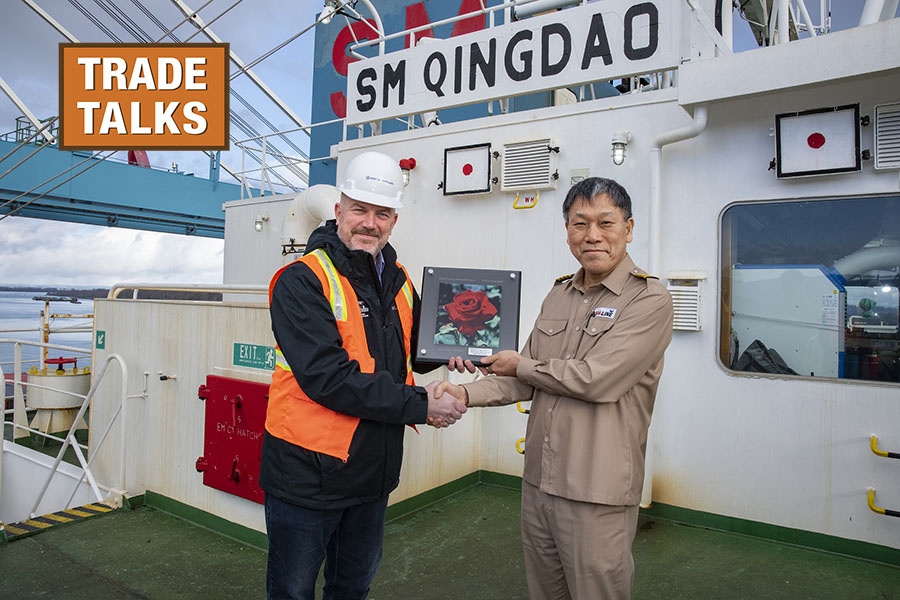The executive director of the Port of Portland discusses how a rising Asian middle class and international e-commerce have boosted Oregon’s trade outlook.
Despite a global economic downturn and four months of the pandemic when shipping overseas was impossible, the Port of Portland has seen a 9% increase in business year-over-year.
Curtis Robinhold, executive director of the port, expects this uptick in trade to continue.
The rise of a middle class in Asia, combined with COVID-19’s acceleration of e-commerce, have created more options for vendors seeking to find business overseas. Robinhold discusses how pandemic trends have benefited the port, and what the new international trading landscape will mean for Oregon shippers.
This interview has been edited for length and clarity.
Why has COVID-19 accelerated international trade?
Folks are sitting at home in Singapore and Taiwan and now they can suddenly order Oregon wine.
The trade trends that were already underway have been accelerated by COVID-19. We are increasingly seeing another crop of Asian countries entering the purchasing space.
South Korea is at the top of that list. South Korea is already Oregon’s fourth largest trading partner and I expect that to grow. It’s interesting because South Korea is starting to look like Japan looked for Oregon 30 years ago. They have done really good business here over the last year, and it has been sustained. We have a direct shipping line to South Korea.
What Oregon industries are going to benefit?
The products that will be most interesting going forward are those that are going to be purchased by the growing middle class in Asia: Dungeness crab, cherries, blueberries, raspberries. Hazelnuts are already an established market.
Oregon wine is another. I’ve already been to some countries with Sokol Blosser and A-Z Wineworks to talk about how to connect with Asian markets.
Most of the increase in online purchasing has come in the form of consumer durables — furniture and TVs. The already existing pathways are seeing more and more demand increases — and relatively quickly. This has driven a lot of congestion.
RELATED STORY: Finding a New Path
Has the Port of Portland experienced the same kind of congestion affecting other ports around the world?
Our container service hasn’t experienced the same level of congestion as other ports around the country and around the world. It’s in large part due to our scale. But we also have a lot of unloading options for our shippers. We have two rail lines and Interstate 5 going north and south. That leads to good turnaround times for vessels.
But we are seeing major congestion up and down the West Coast and globally. The recent blockage of the Suez Canal was a huge signal of how congestion can impact supply chains.
There has been a push globally for these larger and larger vessels, but it all comes down to how much cargo you can handle. We’re learning that bigger isn’t always better.
Are there any markets that are looking less profitable?
Navigating other countries’ COVID-19 requirements has been challenging. Travel across the Pacifc takes two weeks. If you get a [COVID-19] case on a ship, you know how to contain it. It’s going to be some time before we get back to normal on the aviation side. I expect it will take a full year before we see the light at the end of the tunnel.
It’s been rough with Germany and the United Kingdom – not because they haven’t had an effective response [to COVID-19] but because the response has been a little herky-jerky. That’s getting better now.
Brazil and Mexico are going to have problems for shippers for a very long time because they haven’t had an effective COVID-19 response. Oregon companies that rely on them for trade are going to be struggling for a very long time.
Do you expect the surge of international trade to continue?
I expect the increase we saw this year to carry over into next year as well. We continue to fill containers with agriculture products bound for Asia. We learned some lessons during the pandemic, and now it’s looking like people are back in the game. That’s reflected in our own numbers across the port.
Our current status relative to trade is looking pretty good. The average price of an Oregon shipping container bound for Asia tripled from a year ago, from $1,500 to $4,600. It’s a pretty astonishing shift.
Right now, shippers are bearing the cost of the increase in e-commerce demand, but eventually that cost will hit the consumer.
To subscribe to Oregon Business, click here.



